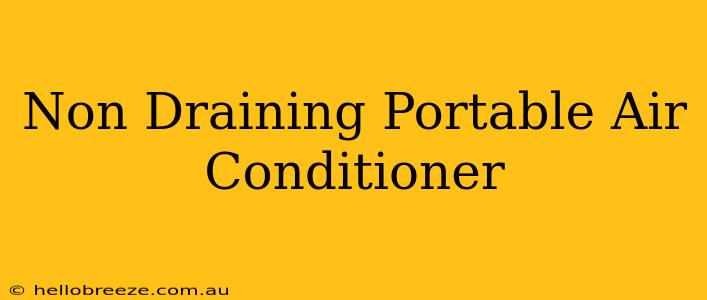Summer heat relentless? Wish you could enjoy cool comfort without the constant hassle of draining a portable air conditioner? You're in luck! This guide dives deep into the world of non-draining portable air conditioners, exploring their benefits, features, and how to choose the best one for your needs.
What are Non-Draining Portable Air Conditioners?
Unlike traditional portable AC units that require regular emptying of their water collection tanks, non-draining portable air conditioners utilize advanced technology to manage condensation. This innovative design eliminates the need for manual draining, offering a significantly more convenient and hassle-free cooling experience. Instead of collecting water, these units either evaporate the condensation or use a self-evaporative system.
How Do They Work?
These units employ various methods to handle condensation, primarily:
- Self-Evaporative Systems: These systems use the heat from the condenser to evaporate the collected water, minimizing or eliminating the need for manual drainage. This is the most common method in non-draining portable AC units.
- Advanced Condensation Management: Some models use innovative designs and efficient cooling processes to reduce condensation significantly.
Benefits of Choosing a Non-Draining Portable AC Unit
The advantages of choosing a non-draining portable air conditioner are undeniable:
- Convenience: Say goodbye to the constant interruption of emptying water tanks. Enjoy uninterrupted cooling without the hassle.
- Reduced Maintenance: Less frequent maintenance translates to more time spent enjoying cool comfort and less time dealing with upkeep.
- Increased Efficiency: Some models are designed to improve energy efficiency by reducing water buildup.
- Peace of Mind: No more worrying about overflowing water tanks or unexpected leaks.
Key Features to Look for When Buying
When selecting a non-draining portable air conditioner, consider these key features:
- BTU Capacity: Choose a BTU rating appropriate for the size of the room you want to cool. Higher BTU means more powerful cooling.
- Energy Efficiency (EER/SEER): Look for higher EER/SEER ratings to ensure energy savings.
- Noise Level: Some units can be quite noisy; check the decibel rating to find a quieter model.
- Smart Features: Some models offer smart home integration, allowing for remote control and scheduling.
- Filter Type and Cleanability: Easy-to-clean filters ensure better air quality and maintain the unit's performance.
Non-Draining vs. Traditional Portable Air Conditioners: A Comparison
| Feature | Non-Draining Portable AC | Traditional Portable AC |
|---|---|---|
| Water Drainage | No manual drainage required | Requires regular emptying of water tank |
| Convenience | High | Low |
| Maintenance | Less frequent | More frequent |
| Potential Issues | Potential for slightly higher initial cost | Risk of overflowing water tanks |
Choosing the Right Non-Draining Portable Air Conditioner for Your Needs
The best non-draining portable air conditioner for you depends on several factors:
- Room Size: Determine the square footage of the area you need to cool to choose the appropriate BTU rating.
- Budget: Non-draining models can range in price, so set a budget beforehand.
- Features: Consider which features are most important to you (smart features, noise level, etc.).
By carefully considering these factors, you can find the perfect non-draining portable air conditioner to beat the heat this summer. Enjoy the convenience and comfort of cool air without the constant worry of water drainage!

